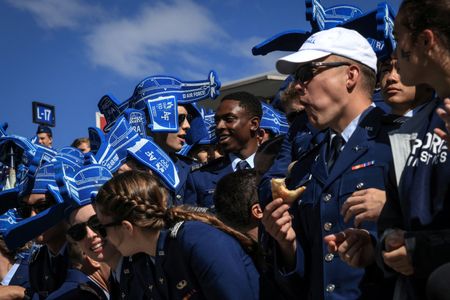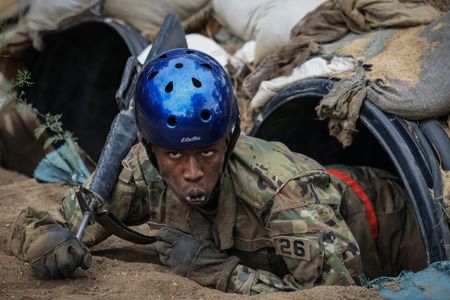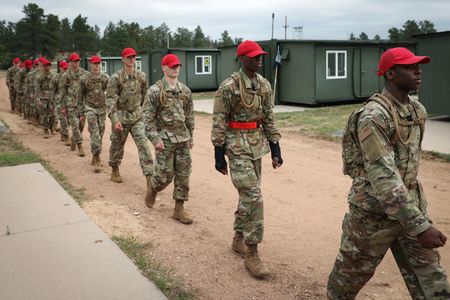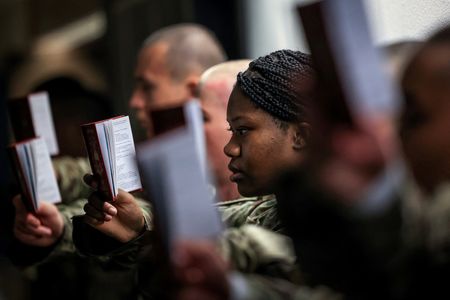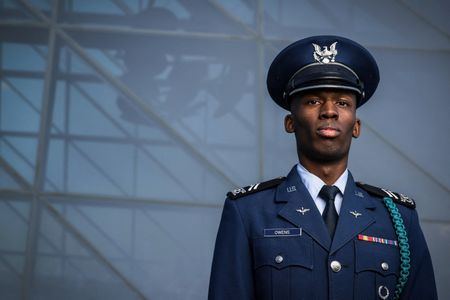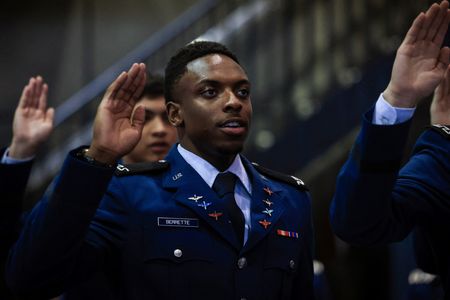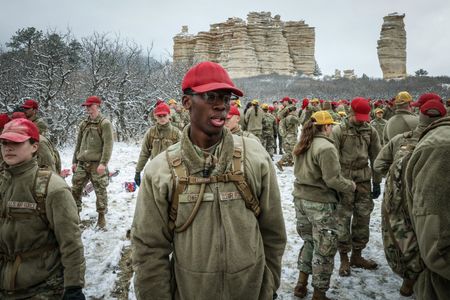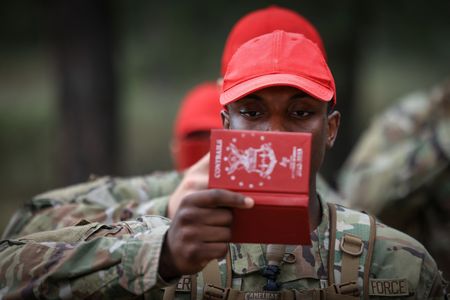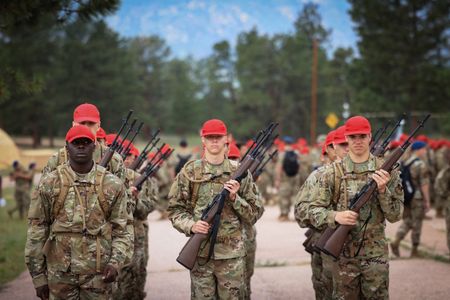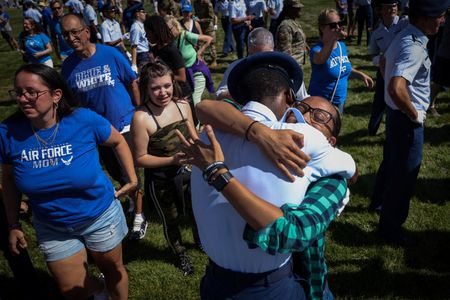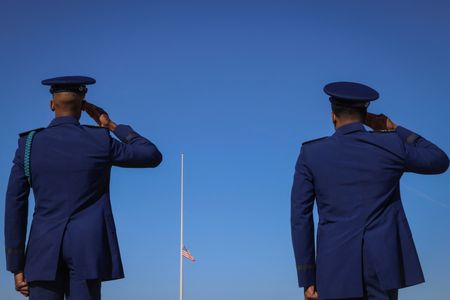By Donna Bryson
COLORADO SPRINGS, COLORADO (Reuters) – Pale marble pavers crisscross the Terrazzo, the plaza at the heart of the U.S. Air Force Academy in Colorado that cadets traverse daily, on the way to class, the library and meals.
In their first year, cadets must run and keep to the narrow marble strips whenever they are on the 20-acre Terrazzo.
Tusajigwe Owens doesn’t take short cuts. He is one of 112 Black cadets in the class of 1,071 freshmen that started at the academy in June 2022.
Running the strips helps instill a sense of urgency and attention to detail that “absolutely matters for the success of yourself and the success of your team,” he said.
Older cadets share coping strategies such as organizing schedules to minimize Terrazzo trips, or walking when the marble is slippery in wet weather.
“They would rather see you succeed,” Owens said.
Not everyone will. The graduation rate for Black cadets has for the last decade averaged 66%, compared to an overall graduation rate of 80%.
That gap has frustrated the Air Force’s stated objective of increasing diversity in its officer corps.
Only 6% of officers identify as Black, compared to about 17% among enlisted members of the Air Force, according to the Air Force Personnel Center.
Those figures have changed very little in the last 20 years, according to an Air Force spokesperson.
By comparison, around 13% of America’s population is Black.
On June 29, days after Owens finished his first year, the U.S.
Supreme Court struck down race-conscious admissions at Harvard University and the University of North Carolina in a case brought by Students for Fair Admissions (SFFA), a group that argues that affirmative action policies discriminate against white and Asian American people.
Chief Justice John Roberts exempted military training academies from the decision, citing the U.S.
government argument that the legitimacy of the armed forces would be undermined by having an overwhelmingly white officer corps leading much more diverse enlisted ranks.
In the fall, the SFFA expanded its challenge to the military’s elite training academies, suing to block the U.S.
Military Academy at West Point, New York, and the U.S. Naval Academy at Annapolis, Maryland, from considering race as a factor in admissions.
The Supreme Court in February declined an SFFA request to intervene in the West Point case.
SFFA founder Edward Blum told Reuters the group would continue to challenge the military’s admissions policies through the lower courts, where the cases are currently being heard.
West Point, the U.S.
Naval Academy and the Air Force Academy declined to comment on the SFFA court cases. A Pentagon spokesperson said that Secretary of Defense Lloyd Austin remains deeply committed to building an officer corps that draws on “the full strength of the American people.”
Reuters was granted access to the Air Force Academy for the most sustained reporting on the facility since the early 2000s.
ENGLISH CLASSES AND MARCHING
Journalists visited the campus in Colorado Springs, Colorado, a dozen times over the course of an academic year, interviewing Owens and a fellow African American freshman, Marcus Berrette, as well as eight members of the institution’s leadership team in the presence of an academy spokesman.
Their responses on matters of race were complex.
Reuters also spoke to two Black men who entered the academy in 2006 and did not graduate with their class.
Owens and Berrette, both now sophomores, academy officials and the former cadets offered no definitive explanations for the higher drop-out rate among African American cadets.
Still, they pointed to what they see as several contributing factors.
Academy officials referenced the small number of Black cadets. Cadets pointed to the importance the academy placed on hierarchy and tradition.
Officials and students also mentioned the country’s broader legacy of racism and underestimating Black potential.
An academy spokesperson said that the institution is “unsettled” by the higher drop-out rates among African American cadets and is working to combat it by bringing more Black students to campus and committing to their success.
The spokesperson said the academy would continue to consider race among factors for admission, in addition to gender and geography.
The Class of 2026 arrived on a bright June day in 2022.
The first of their four years at the academy would involve studying “Contrails,” a breast-pocket-size manual of academy lore, and revered Air Force figures such as Jimmy Doolittle, who led the first bombing raids on Tokyo after the Japanese attack on Pearl Harbor.
The cadets would also have to get used to wearing uniforms to class and to dorm rooms equipped with racks for M-16 rifles, rendered inoperable, that cadets carry during military games.
And marching. So much marching.
That’s alongside what freshmen anywhere might have encountered: football games, chemistry tests, English papers.
Owens, born in 2002 in Philadelphia, planned to major in military strategic studies.
While he chose the military, Owens said his mother, a nurse, and his father, an IT manager, modeled service and leadership for him at work, church and home.
Berrette, born in 2004 in Fort Myers, Florida, is the son of an Air Force officer.
He has wanted to be a pilot since he was five years old, when he ran across books about planes at a school book fair. He planned to major in aeronautics.
His passion for flight inspired his mother, Ermita Charles-Berrette, to leave her job as a nurse and sign up for the Air Force too.
She joined in 2012 on a leadership track – the academy is not the only way to become an officer – and was recently promoted to major.
As the school year started, Owens and Berrette marched onto a parade ground with the rest of their class to take the academy oath: “I will not lie, steal or cheat nor tolerate among us anyone who does.
Furthermore, I resolve to do my duty and to live honorably, so help me God.”
Before he came to the academy, Berrette said he spoke to Black alumni who said he would have to work twice as hard as white cadets to gain recognition and could expect harsher punishment if he got into trouble.
But Berrette and Owens never spoke to Reuters of being discouraged.
BIAS TO OUTRIGHT DISCRIMINATION
In 1959, five years after its founding, the academy admitted its first Black students, three men in a class of 755.
All three were among the 499 graduates of the class of 1963.
By 2008, the year Barack Obama was elected America’s first Black president, among the 1,286 students who started at the academy, just 47 were Black, or fewer than 4%.
Daryl Wells, who is Black and was then in his junior year at the academy, recalls a drawing he saw circulated among his fellow cadets during that election season showing a trap baited with watermelon – an old racist trope aimed at Black Americans – and a caption referring to Obama.
He said a white cadet, whom he declined to name, told him: “You weren’t supposed to see that.”
“I didn’t realize how racist it (the academy) was until the advent of Obama,” Wells said.
“It was probably just a concentrated version of America at large.”
Wells, now a Houston real estate agent, said he left the academy at the start of his senior year because of a personal crisis over his realization that he was gay.
He returned to graduate in 2011, a year behind his class, and completed the five years of active-duty military service required of academy graduates in return for free college education.
Wells said the racism he encountered did not influence his decision to leave and would not impact whether he would advise anyone to go.
“That’s not how you fix the problem, not by shying away from these places,” Wells said.
“You have to deal with things in order for the next generation not to have to deal with them.”
The academy did not respond to requests for comment on Wells’ account of his experiences.
In 2020, nine years after Wells graduated, the Air Force Inspector General issued its first report into racial disparities in the service.
It found lower than average promotion rates for Black officers across all ranks, and that one in three Black officers did not believe the Air Force provided them the same opportunities to advance as their white peers.
“Thousands of Black service members and civilians reported issues ranging from bias to outright racial discrimination,” the inspector general wrote.
An academy spokesperson said the institution trains cadets to report discrimination up the chain of command.
Affirmative action in the military and its academies is part of a charged debate.
Lawmakers including Rep. Tom Tiffany, a Wisconsin Republican who has not served in the military, have portrayed such policies, including at military academies, as discriminatory.
“It’s pretty simple.
If we are serious about ending discrimination in the United States, the first step is for the government to stop doing the discriminating,” Tiffany told Reuters in an email.
Rep. Jason Crow, a Colorado Democrat and former Army Ranger, said that while understanding did not hinge on military experience, his own service had taught him the importance of building a military that reflects the country’s diversity.
“Usually, people who have served and who know something about national security and military service really do support this,” Crow told Reuters.
FINDING INSPIRATION
As classes got underway, Berrette was pleased to find a reading assignment on the Harlem Hellfighters, the Black infantry regiment that spent 191 days in combat during World War One, longer than any other American unit.
In the spring of 2023, Berrette perused the program for an on-campus leadership symposium, noting Eddie S.
Glaude Jr., chair of Princeton University’s Department of African American Studies, would be speaking about the threat white supremacy poses to democracy.
“It’s just always interesting to see how our brothers and sisters made it to the top,” Berrette said.
“It’s not always easy.”
During a question-and-answer session which a Reuters reporter attended, a white cadet said some of his classmates were angry at having to take part in Diversity, Equity and Inclusion (DEI) workshops.
Glaude drew a standing ovation when he counseled cadets to press on, saying leaders have to say, “at some point, ‘Shut the hell up and let’s go.'”
When Reuters told Joseph Looney, the academy’s chief DEI officer, about the white cadet’s question to Glaude, Looney said: “That didn’t surprise me.
We’ve got that feedback a little bit.”
Competition for a place at the academy is intense and usually requires nomination by a state’s congressional representative.
Each member of Congress is allowed to nominate up to 10 candidates, and up to five cadets from any district can attend the academy at one time.
Col.
Arthur Primas Jr., who until recently served as the academy’s director of admissions, said he dispatches diverse recruiters to reach out to high school guidance counselors and visit schools in communities of color.
The Supreme Court ruling on race-conscious university admissions did not address recruitment.
“I think the academy does an excellent job now of celebrating those diverse graduates who have gone on to do great things,” Primas said, adding that it shows potential students “what is possible.”
GAINING ENTRY IN THE FIRST PLACE
When Owens approached lawmakers in his home state of Pennsylvania for a nomination in 2021, he said he was told he didn’t appear ready.
Owens had been homeschooled and didn’t have a high class ranking or extra-curricular activities. So he enrolled in the academy’s on-campus, 10-month prep school, open to anyone whose initial application to the academy is unsuccessful.
Democratic Senator Bob Casey’s office confirmed it nominated Owens the following year.
Berrette also attended the prep school, where tuition is free. “They’re willing to invest in you to make you completely eligible for the academy,” Berrette said.
Enlisted members of the Air Force and other services also can apply to the prep school, allowing the school to tap into a larger pool of minorities.
On average, African American students have made up about 28% of the prep school classes since 2014.
While entrance to the academy from the prep school is not ensured, it is “instrumental” for preparing many diverse candidates, Primas said.
Over the past decade, a total of 1,787 prep school graduates have been admitted to the academy.
Of those, 396, or 22%, have been African American.
Russell Roberts enrolled at the academy in 2006 planning to study engineering after being recruited to play football, the first in his family to attend a military academy.
He said white cadets, whose names he no longer remembers, often told him that they expected him to fail.
When he did well on tests, suspicious white cadets told him they would figure out whether he had cheated and report him if he had.
“There wasn’t a single Black cadet that gave me that treatment,” he said.
Black upperclassmen instead tried to make first-year cadets feel at home by, for example, cutting their hair, Roberts said, adding that the academy barbers were unaccustomed to cutting Black hair.
“I do feel like some of it (the treatment) was race-related, but I don’t want to say it was racist,” he said.
Because of his hostile treatment at the academy, Roberts said, he transferred to a school in Texas that had also recruited him to play football.
He’s now a manager at a big box store in Houston.
The academy did not respond to requests for comment on Roberts’ experience.
Some days, Owens said, he looks at his fellow cadets and sees “descendants of generals, of individuals who have been in the Air Force for decades.”
It’s a point of pride for Owens that he is there, too.
“I wasn’t born into a family where my dad’s name would get me into the right school,” Owens said.
“I feel like I had actually to earn this.
The academy began reducing the extent to which legacy was taken into account for admissions in 2013 and eliminated it entirely in 2022.
FOLLOWERSHIP TO LEADERSHIP
Freshmen cadets are known as Doolies, after World War II hero Doolittle.
Some cadets say the name comes from the Greek for slave – doulos. That’s an explanation academy leaders say they would like to put behind them.
Cadets in their first year are meant to look to upperclassmen for direction as a step toward one day being leaders themselves.
“It’s not easy being a Doolie.
I wake up every day thinking, ‘I wish I could do more,'” Owens said.
Owens has expressed concern that cadets are too often treated as numbers: their GPA or class rankings that determine who gets coveted assignments such as a place in flight school.
“I was worried I would face racism here,” Owens told Reuters.
But “I’ve been talked down to more because of my class rank than because I’m a Black man.”
At year’s end, Owens was named the top cadet among his squad’s 26 Doolies, an honor that squad supervisor Lt.
Col. Jessica Pratt attributed to the effort Owens put into military training and his dedication to helping others.
On May 22, Owens stood in the football stadium with his fellow cadets to salute the graduation speaker – President Joe Biden, their civilian commander in chief.
Biden noted that the Class of 2023 was one of the most diverse in the institution’s history.
A third were minorities, according to academy figures.
“That’s why we’re strong,” Biden told the cadets. “That’s why we’re who we are.”
(Reporting by Donna Bryson in Colorado Springs, Colorado.
Additional reporting by Phil Stewart; Editing by Suzanne Goldenberg)


